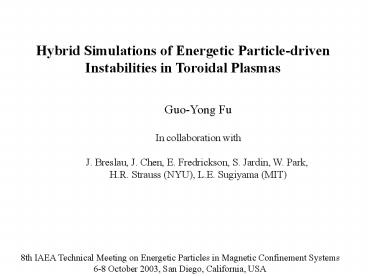Hybrid Simulations of Energetic Particledriven - PowerPoint PPT Presentation
Title:
Hybrid Simulations of Energetic Particledriven
Description:
Mode Structure: Ideal Kink v.s. Fishbone. ITER: alpha particle ... stabilize n=1 internal kink mode. Fast Ion-driven TAE in a Quasi-symmetric stellarator ... – PowerPoint PPT presentation
Number of Views:47
Avg rating:3.0/5.0
Title: Hybrid Simulations of Energetic Particledriven
1
Hybrid Simulations of Energetic
Particle-driven Instabilities in Toroidal Plasmas
Guo-Yong Fu In collaboration with J. Breslau,
J. Chen, E. Fredrickson, S. Jardin, W. Park,
H.R. Strauss (NYU), L.E. Sugiyama (MIT)
8th IAEA Technical Meeting on Energetic Particles
in Magnetic Confinement Systems 6-8 October 2003,
San Diego, California, USA
2
Outline
- Introduction
- M3D code hybrid model, code development
- Examples of M3D Hybrid Simulations
- NBI-driven TAEs in NSTX
- Summary
- Future Work
3
Introduction
- We investigate energetic particle-driven MHD
modes in tokamaks and stellarators by
particle/MHD hybrid simulations - Our main tool, M3D, is a 3D global nonlinear
extended MHD code. - Our goal is to understand the alpha
particle-driven MHD instabilities in a burning
plasma and predict their effects on alpha heating
and particle loss. - This talk reports progress towards this goal
code development, NBI-driven Alfven modes etc.
4
Motivation
- In a toroidal plasma (tokama/stellarator),
energetic particles with velocity comparable to
Alfven phase speed can resonantly destabilize MHD
modes such as TAE and CAE, they can also
induce/excite new modes such as fishbone or
Energetic Particle Mode(EPM). - In a magnetic fusion reactor, alpha
particle-driven MHD modes can results in alpha
particle loss and change alpha heating profile. - Key issues of alpha physics are alpha effects on
sawteeth and alpha particle transport due to
multiple Alfven modes.
5
M3D code
M3D project is part of SciDACs CEMM Center
for Extended MHD Modeling M3D is an extended-MHD
(XMHD) code which has multi-level of
physics Resistive MHD Two fluids Particle/MHD
hybrid
6
M3D XMHD Model
7
(No Transcript)
8
M3D Hybrid Code Development
- extended to general 3D geometry valid for
stellarators - massively parallelized via MPI
- benchmarked against NOVA-K code.
9
M3D hybrid code has been extended to
unstructured mesh valid for 3D geometry
10
M3D hybrid code has been parallelized using
either MPI or OpenMP
512 poloidal planes 7321 mesh points 32 million
particles
1 node 16 processors
11
Examples of M3D Hybrid Simulations
- Fishbone instability
- ITER Alpha particle effects on n1 kink
- TAE in stellarators.
12
Hot Particle-induced Fishbone Instability
circular tokamak R/a2.76 q(0)0.6,
q(a)2.4 b_total(0) 8 v_h/v_A 1.0,
r_h/a0.05 Isotropic slowing-down hot particle
distribution
13
Mode Structure Ideal Kink v.s. Fishbone
14
ITER alpha particle effects are not sufficient
to stabilize n1 internal kink mode
15
Fast Ion-driven TAE in a Quasi-symmetric
stellarator
16
TAE mode structure tokamak v.s. stellarator
17
(No Transcript)
18
Simulations of Beam-driven Alfven Modes in NSTX
- Recent NSTX experimental observations show rich
beam-driven instabilities fishbone, TAEs, CAEs
etc and associated hot particle losses. - Alfven modes in STs are less understood as
compared to those in conventional tokamaks. - Need to study possible new features of
beam-driven Alfven modes associated with STs
unique parameter regime low aspect ratio, high
beta, large energetic ion speed and gyroradius.
19
The bursting modes are in the TAE frequency range
(NSTX)
E. Fredrickson
- Multiple modes burst at the same time.
- Toroidal mode number, n, ranges from 2 - 5 with
the dominant mode being n2 or 3. - Mode frequencies in reasonable agreement with
expected TAE frequencies.
20
The final mode growth and decayis very fast
E. Fredrickson
- Some of the mode amplitude modulation represents
"beating" of the multiple modes. - Mode growth and decay times are approximately 50
- 100 ms.
21
NSTX Parameters and Profiles
- NSTX shot 108530 at t0.267sec
- R87cm, a63cm, B0.43T, ne(0)2.5e13, Ti1.7kev,
Te1.4kev - q(0)1.82, q(a)12.9, weakly reversed
- b(0)21, bbeam(0)13
- vbeam/vAlfven 2.1, rbeam/a 0.17
22
q profile
23
Pressure Profiles Pthermal and Pbeam
24
Beam Particle Distribution
- isotropic distribution
- anisotropic distribution.
25
The simulation of an NSTX plasma show unstable
TAEs consistent with observations
- NSTX shot 108530 at t0.267sec
- The calculated n2 TAE mode frequency is 73 kHz
which is close to the experimental value of 70
kHz (assuming 15kHz toroidal rotation)
26
N1, 2 3 Modes in NSTX
27
Nonlinear Evolution of n2 TAE Mode Saturation
and Frequency Chirping
28
Mode Moving Out After Saturation
29
n2 Mode Structure Isotropic v.s. Anisotropic
distribution
30
Multiple Mode Simulations (n14)
t180
t220
t270
t139
31
Summary
- M3D hybrid code has been extended to general 3D
geometry and massively parallelized. - Simulations of NBI-heated NSTX plasmas show
unstable TAEs with frequencies consistent with
experimental observations. - Initial nonlinear simulations show that the n2
TAE mode moves out radially and its frequency
chirps down during saturation.
32
Future Work
- Simulations of NBI-driven TAE in NSTX for more
realistic distributions - Improve M3D for simulations of alpha-driven
high-n Alfven modes in burning plasmas code
speed, time step, more physics such as particle
collision etc.































